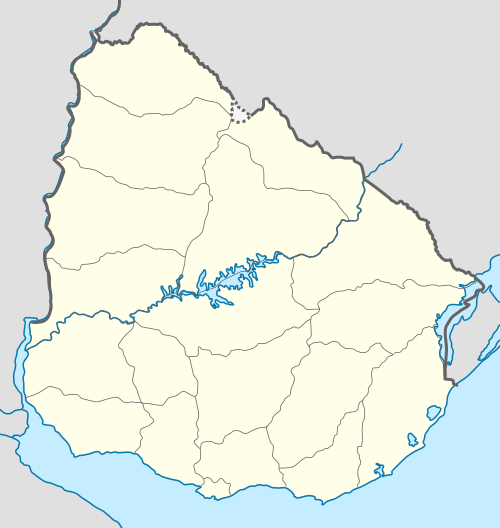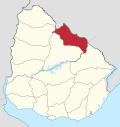Minas de Corrales
Minas de Corrales is a town in the Rivera Department of northeastern Uruguay.
Minas de Corrales | |
|---|---|
Town | |
 Minas de Corrales Location in Uruguay | |
| Coordinates: 31°34′0″S 55°28′0″W | |
| Country | |
| Department | Rivera Department |
| Population (2011) | |
| • Total | 3,788 |
| Time zone | UTC -3 |
| Postal code | 40002 |
| Dial plan | +598 4658 (+4 digits) |
Location
The town is located on the banks of the stream Arroyo Corrales, on the intersection of Route 28 with Route 29, about 95 kilometres (59 mi) south of the city of Rivera.
History
In 1878 the mining company Compañía Francesa de Minas de Oro del Uruguay started looking for gold in the area, giving thus birth to the town. From the end of December 1879 to the start of March 1880 Henry Küss visited Uruguay to evaluate the gold concession on the Arroyo Corrales. The company was looking for at least 8 million francs to develop the mines. Küss undertook a careful survey of the mineralogy. His report was unenthusiastic, saying only that it might be worth spending two or three hundred thousand francs on a more systematic study.[1] In 1902 the railway line was inaugurated, which operated until 1916, when the company ended. On 9 November 1920, it was declared a "Pueblo" (village) by the Act of Ley Nº 7.299,[2] and on 13 December 1994, its status was elevated to "Villa" (town) by the Act of Ley Nº 16.669.[3]
In 1997 the mining operations resumed by the company Uruguay Mineral Exploration (UME).[4][5]
Population
In 2011 Minas de Corrales had a population of 3,788.[6]
| Year | Population |
|---|---|
| 1963 | 2,793 |
| 1975 | 1,377 |
| 1985 | 2,426 |
| 1996 | 2,938 |
| 2004 | 3,444 |
| 2011 | 3,788 |
Source: Instituto Nacional de Estadística de Uruguay[2]
Places of worship
- St. John Bosco Parish Church (Roman Catholic)
Nearby attractions
About 15 kilometres (9.3 mi) towards the west of the town is the scenic area Rincón de Tres Cerros. Although the whole area is best visible from along the banks of Tacuarembó River, the hills can be approached by a road splitting south from Route 29, 15 kilometres (9.3 mi) after Minas de Corrales.
References
- Lallemand, Ch. (1922), "Notice Necrologique Sur Henri Kuss : Inspecteur Général Des Mines, Directeur De L'école Nationale Supérieure Des Mines", Annales des Mines, II, retrieved 2017-08-05
- "Statistics of urban localities (1963–2004)". INE. 2012. Archived from the original (PDF) on 23 March 2015. Retrieved 4 September 2012.
- "Ley Nº 16.669". República Oriental del Uruguay, Poder Legislativo. 1994. Archived from the original on 4 March 2016. Retrieved 4 September 2012.
- "Rivera". El Observador. 6 May 2010. Archived from the original on 2012-12-29. Retrieved 26 February 2012.
- "San Gregorio Operation". Orosur Mining. 2011. Archived from the original on 18 March 2012. Retrieved 26 February 2012.
- "Censos 2011 Cuadros Rivera". INE. 2012. Archived from the original on 10 October 2012. Retrieved 25 August 2012.
External links
| Wikimedia Commons has media related to Minas de Corrales. |
- INE map of Minas de Corrales
- Intendencia Departamental de Rivera / Minas de Corrales
- Map showing the mining sites near Minas de Corrales
